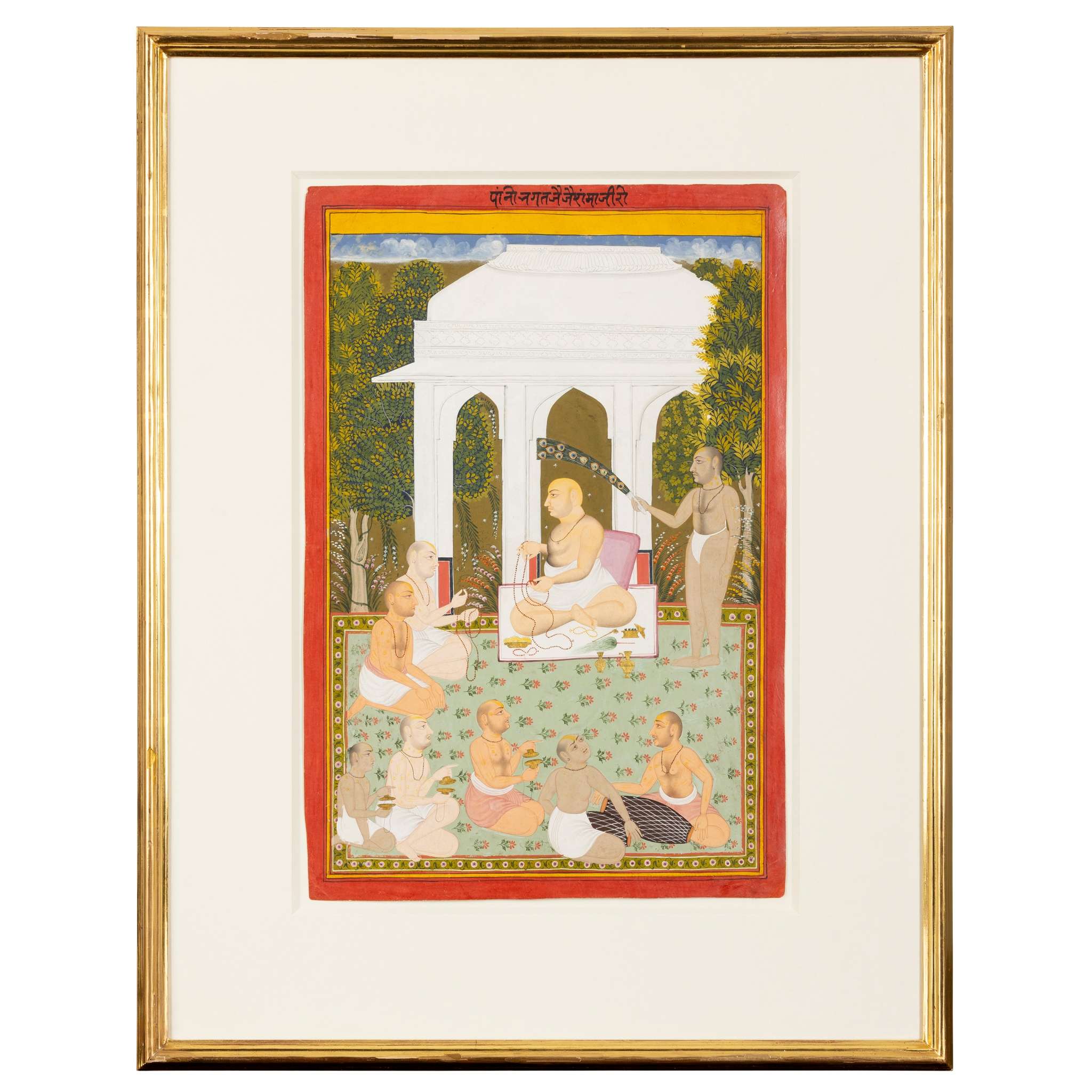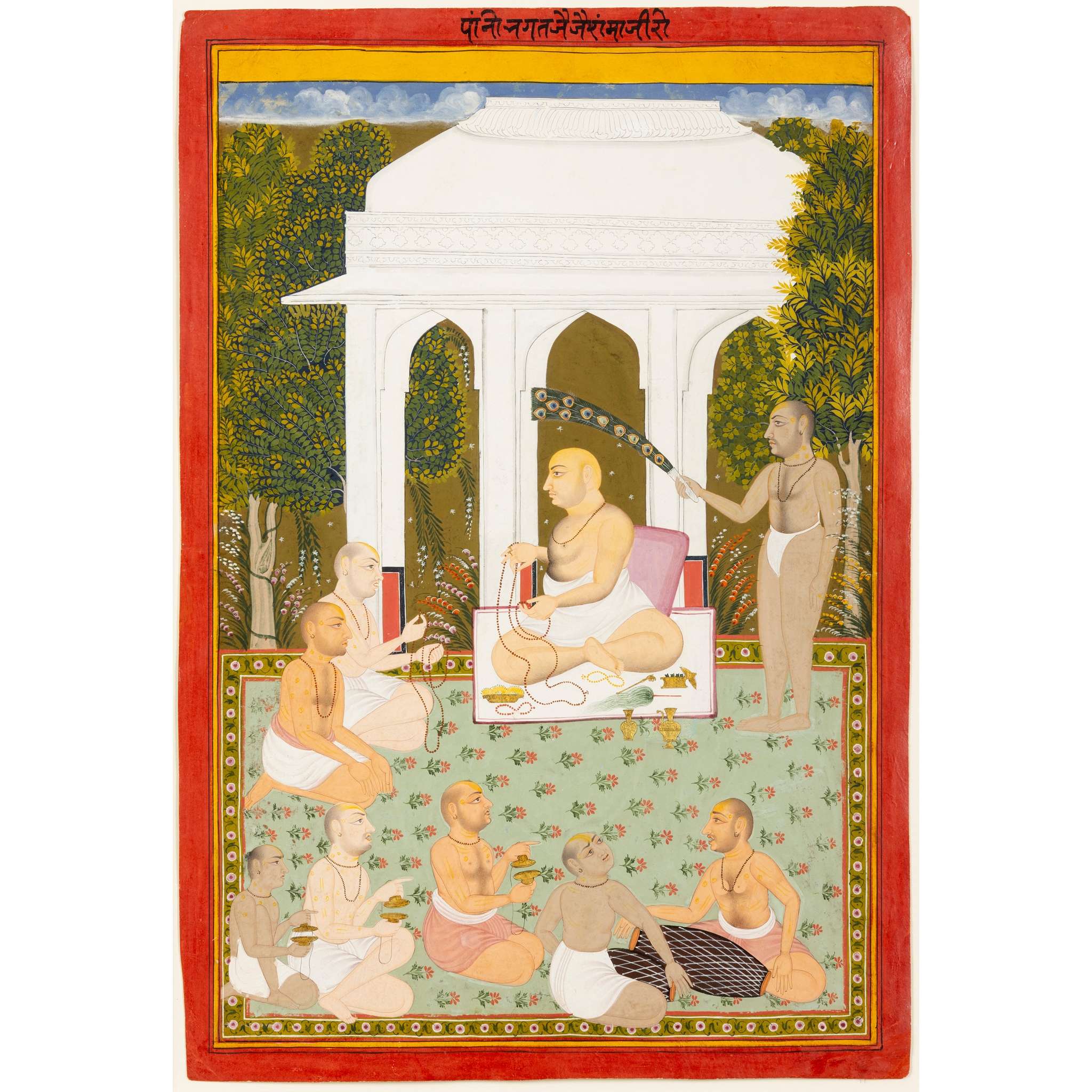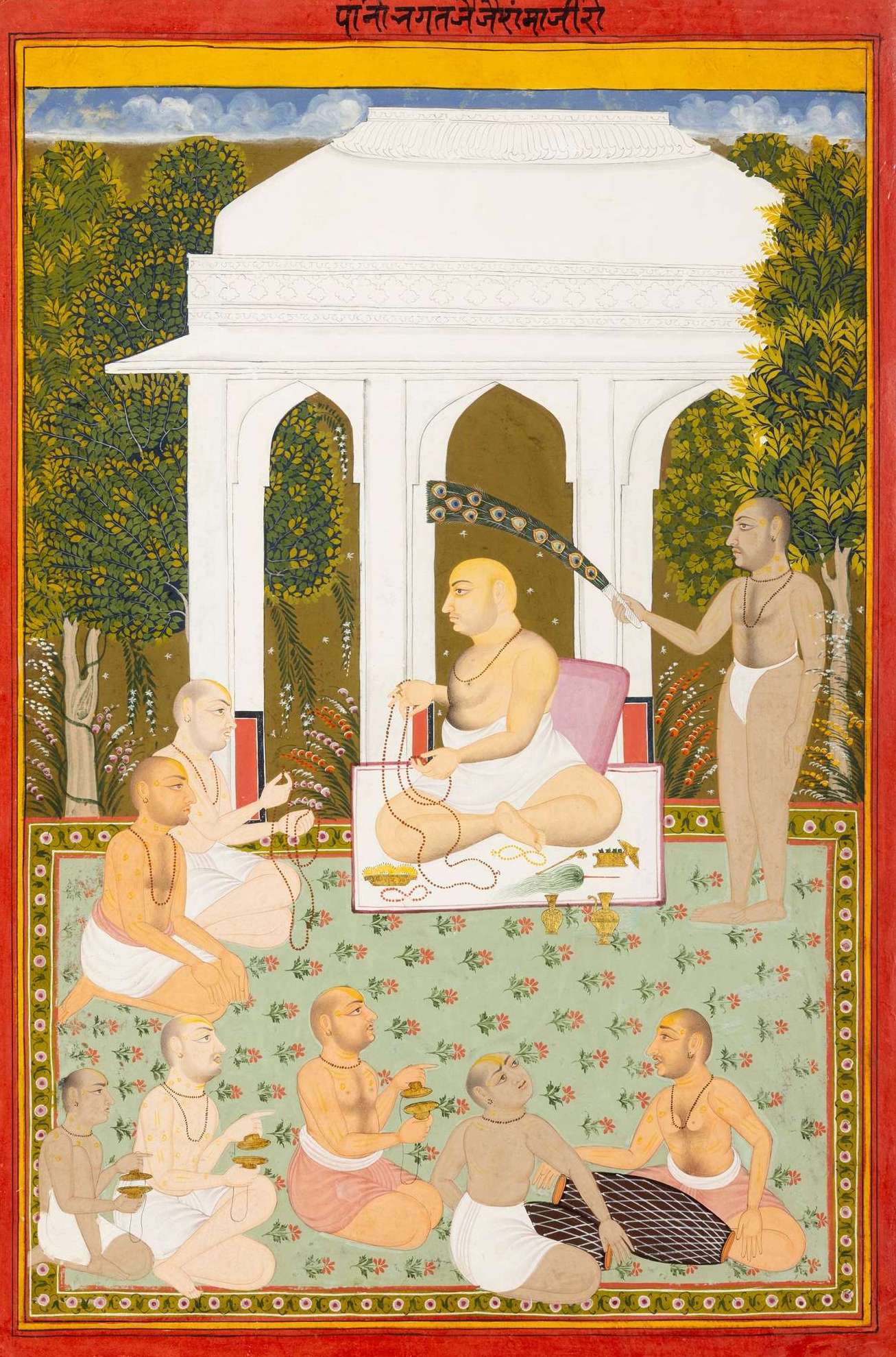99
THE ACHARYA JAIJAIRAM JI AND DEVOTEES LISTENING TO DEVOTIONAL CHANTS
INDIA, RAJASTHAN, UDAIPUR, CIRCA 1745
gouache heightened with gold on paper, inscribed to the top of the red border in devanagari identifying the impressive figure of Jaijaram, who is seated cross-legged on a white mat in front of white tripolya and holding a long string of prayer beads or rudrakshamala, placed on the mat are adjuncts to meditation including a bowl of cut flowers, a pandan open to reveal fresh betel quids, a chowrie, a back scratcher, lotas and shorter strings of beads, a standing attendant waves a morchal behind him, whilst two priests in front of him are kneeling, one of whom holding strings of beads, below in the foreground three musicians are holding cymbals, and two below right are playing the drums, verso with Mewar royal inventory inscriptions, mounted, glazed and framed
50.5cm x 34.5cm
Sotheby's, London, 8th April 1975, lot 116.Private English Collection.
The name of the acharya Jaijairam and the tilak marks on all their foreheads, consisting of a vertical yellow U with a red stripe, suggest that the devotees are nandis or worshippers of Rama, one of the largest and most egalitarian sects in India. It was founded in the fourteenth or fifteenth century by the saint Ramanada, who preached in simple Hindi and believed that all were equal before God (see A. Dallapiccola, Dictionary of Hindu Love and Legend, 2002, p. 162). He opposed the caste system, admitting women and people of humble origin into his sect. Although not criticising the Hindu pantheon, he made Rama the centre of his devotional movement as he taught that Rama alone could liberate mankind from the cycle of rebirths. Ramanandi ascetics rely upon meditation and strict ascetic practices but also believe that the grace of God is required for them to achieve liberation. Distinguished members of the sect include the mystic poetess Mirabai and Tulsidas, the Awadhi poet regarded as an incarnation of Valmiki, the author of the Ramayana, and celebrated for his Hindi dialect version of the Ramayana, the Ramcharitamanas (see op. cit, Dallapicolla, p. 162).According to Jerry Losty, while artistic activity in the reign of Maharana Jagat Singh (1734–1751) is characterised by large scale paintings of hunts and festivities, there is also a strain of introspective works involving more intimate portrait studies in the last decade of his reign, for example the double portrait of Baba Bharath Singh clothed and half-clothed in the Alvin O. Bellak Collection in Philadelphia. This is published in Andrew Topsfield, Court Painting at Udaipur: Art under the patronage of the Maharanas of Mewar, 2002, p. 144, figs. 165-166. The intention may have been to mock this vastly overweight and rebellious thakur, but the artist manages to imbue him with a certain dignity. As in our portrait of Jaijairam, Baba Bharath Singh is painted with more careful attention to the modelling of flesh than was normally the case in Udaipur at this period.Andrew Topsfield has charted the careers of various Mewar court musicians, through their representations on inscribed paintings, in his article “The Kalavants on their Durrie: Portraits of Udaipur Court Musicians, 1680-1730”, in R. Crill, S. Stronge and A. Topsfield (eds.), Arts of Mughal India: Studies in Honour of Robert Skelton, 2004, pp. 248-263. While these famous named musicians sit decorously in the presence of the Rana, our anonymous priestly musicians vigorously sing and play with an unbridled energy that matches the intense meditation of the devotees.
INDIA, RAJASTHAN, UDAIPUR, CIRCA 1745
gouache heightened with gold on paper, inscribed to the top of the red border in devanagari identifying the impressive figure of Jaijaram, who is seated cross-legged on a white mat in front of white tripolya and holding a long string of prayer beads or rudrakshamala, placed on the mat are adjuncts to meditation including a bowl of cut flowers, a pandan open to reveal fresh betel quids, a chowrie, a back scratcher, lotas and shorter strings of beads, a standing attendant waves a morchal behind him, whilst two priests in front of him are kneeling, one of whom holding strings of beads, below in the foreground three musicians are holding cymbals, and two below right are playing the drums, verso with Mewar royal inventory inscriptions, mounted, glazed and framed
50.5cm x 34.5cm
Sotheby's, London, 8th April 1975, lot 116.Private English Collection.
The name of the acharya Jaijairam and the tilak marks on all their foreheads, consisting of a vertical yellow U with a red stripe, suggest that the devotees are nandis or worshippers of Rama, one of the largest and most egalitarian sects in India. It was founded in the fourteenth or fifteenth century by the saint Ramanada, who preached in simple Hindi and believed that all were equal before God (see A. Dallapiccola, Dictionary of Hindu Love and Legend, 2002, p. 162). He opposed the caste system, admitting women and people of humble origin into his sect. Although not criticising the Hindu pantheon, he made Rama the centre of his devotional movement as he taught that Rama alone could liberate mankind from the cycle of rebirths. Ramanandi ascetics rely upon meditation and strict ascetic practices but also believe that the grace of God is required for them to achieve liberation. Distinguished members of the sect include the mystic poetess Mirabai and Tulsidas, the Awadhi poet regarded as an incarnation of Valmiki, the author of the Ramayana, and celebrated for his Hindi dialect version of the Ramayana, the Ramcharitamanas (see op. cit, Dallapicolla, p. 162).According to Jerry Losty, while artistic activity in the reign of Maharana Jagat Singh (1734–1751) is characterised by large scale paintings of hunts and festivities, there is also a strain of introspective works involving more intimate portrait studies in the last decade of his reign, for example the double portrait of Baba Bharath Singh clothed and half-clothed in the Alvin O. Bellak Collection in Philadelphia. This is published in Andrew Topsfield, Court Painting at Udaipur: Art under the patronage of the Maharanas of Mewar, 2002, p. 144, figs. 165-166. The intention may have been to mock this vastly overweight and rebellious thakur, but the artist manages to imbue him with a certain dignity. As in our portrait of Jaijairam, Baba Bharath Singh is painted with more careful attention to the modelling of flesh than was normally the case in Udaipur at this period.Andrew Topsfield has charted the careers of various Mewar court musicians, through their representations on inscribed paintings, in his article “The Kalavants on their Durrie: Portraits of Udaipur Court Musicians, 1680-1730”, in R. Crill, S. Stronge and A. Topsfield (eds.), Arts of Mughal India: Studies in Honour of Robert Skelton, 2004, pp. 248-263. While these famous named musicians sit decorously in the presence of the Rana, our anonymous priestly musicians vigorously sing and play with an unbridled energy that matches the intense meditation of the devotees.
Islamic & Indian Art
Sale Date(s)
Venue Address
Purchase collections for Islamic & Indian Art (Sale 850)
Purchases will be availble for collection from our London Venue at 22 Connaught St, London, W2 2AF until Wednesday 25th June. After that they will be divided as below.
Contact london@lyonandturnbull.com / calll 0207 930 9115 to book an appointment.
Click here to find out more about suggested carriers
----
COLLECTIONS & STORAGE OF PURCHASED LOTS FOR INTERNATIONAL BUYERS & UK (OUTSIDE SCOTLAND) BUYERS
STORAGE: Items will be stored at 22 Connaught Street, until Wednesday 25th June at 5pm.Thereafter we will store items at Stephen Morris Shipping Ltd., 15 Ockham Drive, Greenford Park, Greenford, UB6 0FD.
Telephone +44(0)20 8832 2222. Items will be available to collect from 9am on Friday 27th June.
Please ensure payment has been made prior to collection. This can be done online, bank transfer or in person at our London office - details will be shown on your invoice also. Please note we are unable to accept cash or payments over the phone.
COST: Please note from Friday 27th June you will be charged by our storage partners.
Insurance 0.25% (all items)
Smalls (paintings and objects) - £2.50 admin fee then £1.00 per day.
Furniture pieces - £5.50 admin fee then £2.50 per day.
FOR SCOTTISH BUYERS
STORAGE: Items will be stored at 22 Connaught Street, until Wednesday 25th June at 5pm.
Thereafter items will be transported to our Edinburgh saleroom and will be available to collect by appointment from 11th July.
All collections will be by appointment only (this applies to both carriers and personal collections).
CALL 0131 557 8844
EMAIL info@lyonandturnbull.com
Important Information
A £6,500 spend limit has been applied to this auction. Bidders intending on spending above this amount will need to provide photo identification to have the spend limit removed. To help manage this, you will be asked to confirm your projected spend as part of the auction registration process. You may receive a request to provide photo ID. We ask that you provide this at your earliest convenience on request, to ensure you are free to bid above the £6,500 spend limit on sale day . Please note it is Lyon and Turnbull’s discretion to ask for identification – you will be also asked to provide this if you have no bidding history.
----
BUYER'S PREMIUM
The buyer shall pay the hammer price together with a premium, at the following rate, thereon.
26% up to £20,000
25% from £20,001 to £500,000
20% thereafter
VAT will be charged on the premium at the rate imposed by law (see our Conditions of Sale at the back of this catalogue).
ADDITIONAL VAT
† VAT at the standard rate payable on the hammer price
‡ Reduced rate of 5% import VAT payable on the hammer price
[Ω] Standard rate of import VAT on the hammer price
Lots affixed with ‡ or [Ω] symbols may be subject to further regulations upon export /import, please see Conditions of Sale for Buyers Section D.2.
No VAT is payable on the hammer price or premium for books bought at auction
REGISTRATION
All potential buyers must register prior to placing a bid. Paddle registration must be completed in advance of the sale day. Please note that all first-time, and those returning after an extended period, bidders at Lyon & Turnbull will be asked to supply the following documents in order to facilitate registration:1 – Government issued photo ID (Passport/Driving licence)2 – Proof of address (utility bill/bank statement).
By registering for the sale, the buyer acknowledges that he or she has read, understood and accepted our Conditions of Sale.
REMOVAL OF PURCHASES
Responsibility for packing, shipping and insurance shall be exclusively that of the purchaser. See Collections & Storage section for more info specific to this particular auction.
COLLECTIONS & STORAGE OF PURCHASED LOTS FOR INTERNATIONAL BUYERS & UK (OUTSIDE SCOTLAND) BUYERS
STORAGE: Items will be stored at 22 Connaught Street, until Wednesday 25th June at 5pm.Thereafter we will store items at Stephen Morris Shipping Ltd., 15 Ockham Drive, Greenford Park, Greenford, UB6 0FD.
Telephone +44(0)20 8832 2222. Items will be available to collect from 9am on Friday 27th June.
Please ensure payment has been made prior to collection. This can be done online, bank transfer or in person at our London office - details will be shown on your invoice also. Please note we are unable to accept cash or payments over the phone.
COST: Please note from Friday 27th June you will be charged by our storage partners.
Insurance 0.25% (all items)
Smalls (paintings and objects) - £2.50 admin fee then £1.00 per day.
Furniture pieces - £5.50 admin fee then £2.50 per day.
FOR SCOTTISH BUYERS
STORAGE: Items will be stored at 22 Connaught Street, until Wednesday 25th June at 5pm.
Thereafter items will be transported to our Edinburgh saleroom and will be available to collect by appointment from 11th July.
All collections will be by appointment only (this applies to both carriers and personal collections).
CALL 0131 557 8844
EMAIL info@lyonandturnbull.com
CATALOGUE DESCRIPTIONS
All item descriptions, dimensions and estimates are provided for guidance only. It is the buyer’s responsibility to inspect all lots prior to bidding to ensure that the condition is to their satisfaction. Our specialists will be happy to prepare condition reports and additional images. These are for guidance only and all lots are sold ‘as found’, as per our Conditions of Sale.
IMPORT/EXPORT
Prospective buyers are advised that several countries prohibit the importation of property containing materials from endangered species, including but not limited to; rosewood, rhino horn, ivory, coral and tortoiseshell. Accordingly, prospective buyers should familiarise themselves with all relevant customs regulations prior to bidding if they intend to import lots to another country. It is the buyer’s sole responsibility to obtain any relevant export or import licence. The denial of any licence or any delay in obtaining licences shall neither justify the recession of any sale nor any delay in making full payment for the lot.
ENDANGERED SPECIES
Please be aware that lots marked with the symbol Y contain material which may be subject to CITES regulations when exporting outside Great Britain. For more information visit https://www.defra.gov.uk/ahvla-en/imports-exports/cites
EXPORT OF IRANIAN WORKS
Iranian origin ‘informational materials’ (including fine art by recognised artists and books and manuscripts) may be imported into the United States and purchased by US persons, but Iranian origin ‘works of conventional craftsmanship’ (works that are not by a recognised artist and/or that have a function) may not. If you are a US person, you are responsible for checking that you do not bid on prohibited Iranian origin property. US persons include US citizens and US permanent residents (‘greencard holders’) wherever these individuals are located, US entities and any other persons temporarily resident or located in the US.
Terms & Conditions
UK - CONDITIONS OF SALE FOR BUYERS
These Conditions of Sale and the Saleroom Notices as well as specific Catalogue terms, set out the terms on which we offer the Lots listed in this Catalogue for sale. By registering to bid and/or by bidding at auction You agree to these terms, we recommend that You read them carefully before doing so. You will find a list of definitions and a glossary at the end providing explanations for the meanings of the words and expressions used.
Special terms may be used in Catalogue descriptions of particular classes of items (Books, Jewellery, Paintings, Guns, Firearms, etc.) in which case the descriptions must be interpreted in accordance with any glossary appearing in the Catalogue. These notices and terms will also form part of our terms and conditions of sales.
In these Conditions the words “Us”, “Our”, “We” etc. refers to Lyon & Turnbull Ltd, the singular includes the plural and vice versa as appropriate. “You”, “Your” means the Buyer.
Lyon & Turnbull Ltd. acts as agent for the Seller. On occasion where Lyon & Turnbull Ltd. own a lot in part or full the property will be identified in the catalogue with the symbol (












